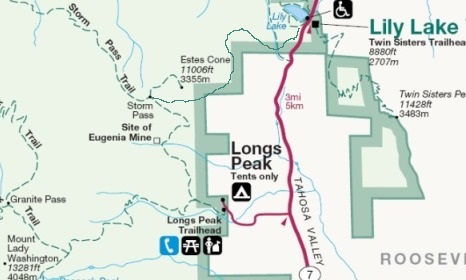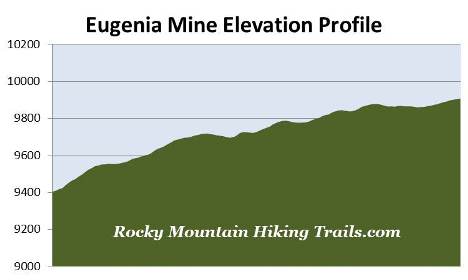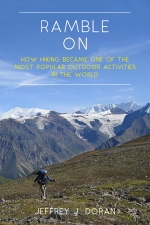Eugenia Mine
| Trail Features: | History, Pleasant Forest Hike | 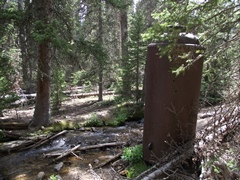 |
|||
| Trail Location: | Longs Peak Trailhead | ||||
| Roundtrip Length: | 2.8 Miles | ||||
| Trailhead Elevation: | 9405 Feet | ||||
| Total Elevation Gain: | 540 Feet | ||||
| Avg. Elev Gain / Mile: | 386 Feet | ||||
| Highest Elevation: | 9908 Feet | ||||
| Trail Difficulty Rating: | 3.88 (easy) | ||||
| Parking Lot Latitude | 40.27215 | ||||
| Parking Lot Longitude | -105.55682 | ||||
Trail Description:
The hike to the Eugenia Mine begins from the Longs Peak Trailhead. To reach the trailhead from Estes Park, drive 8.9 miles south along Colorado Highway 7 to the turnoff for the Longs Peak Ranger Station. From the turnoff drive another mile to the ranger station. Please note that parking is fairly limited, and the lot fills up fairly early, especially on weekends during peak season. Additional parking is available along the roadside leading up to the trailhead, but is also quite limited.
Due to the popularity of the hikes from this trailhead, the length of time to reach most destinations, exposure to afternoon thunderstorms, as well as limited parking, you'll definitely want to arrive as early in the morning as possible, especially on weekends during the summer months. Day hikers planning to summit Longs Peak usually arrive between 3 a.m. and 5 a.m.
Starting at an elevation of roughly 9405 feet, hikers will begin by following the East Longs Peak Trail. From the Longs Peak Ranger Station the trail climbs steeply through a thick forest of lodgepole pine, spruce and fir. Roughly one-half mile from the trailhead you'll arrive at the Eugenia Mine Trail junction. Hikers should turn right here to continue on towards the mine.
At this point you will have already climbed roughly 275 feet. Fortunately the terrain heading towards the mine from this point forward is much easier.
As you proceed towards your destination you may notice Estes Cone peeking through the trees on several occasions. It's the prominent mountain standing almost directly towards the north.
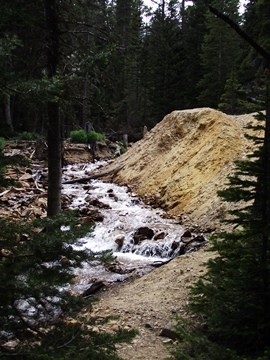
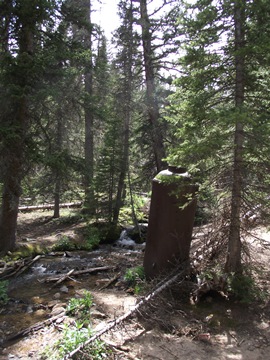
After crossing the footbridge over Inn Brook, roughly 1.4 miles from the trailhead, hikers will reach the site of the historic Eugenia Mine along the eastern slopes of Battle Mountain. At the site are the remnants of an old homestead, a ten-foot vertical steam boiler left standing beside the creek bed, as well as mine tailings just upstream from the trail.
The mine was opened in 1905, and was worked seasonally by Carl Norwell and Dan Slaughter until around 1912. The miners tunneled at least 1500 feet, and installed cart tracks to haul copper sulphide and gold ore out of the mountain. Although the Longmont Ledger proclaimed that "an enormous body of ore has been uncovered," there's no evidence that the men ever made a profit from the venture. Eventually the entrance collapsed, and in the 1960s the national park sealed the mine shaft.
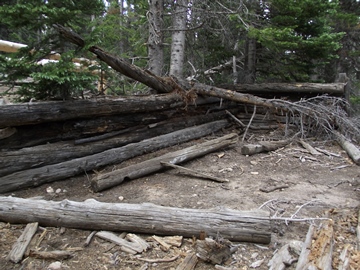 A comprehensive study conducted by the EPA and the National Park Service several years ago found that the tailings from the mine were leaching small amounts of metals into Inn Brook. However, the researchers also concluded that the effects of cleaning up the tailings would be more harmful to the ecosystem than simply leaving them in place.
A comprehensive study conducted by the EPA and the National Park Service several years ago found that the tailings from the mine were leaching small amounts of metals into Inn Brook. However, the researchers also concluded that the effects of cleaning up the tailings would be more harmful to the ecosystem than simply leaving them in place.
Also at the historic site are the remnants of Carl Norwell's home, where he lived with his wife and two daughters. The home was apparently well furnished for the time and place. Among the possessions owned by the Norwell's was a piano which was hauled-in by freight wagon and horses over rough dirt roads. The entertainment the piano provided apparently made the Norwell's quite popular with the locals.
From the old mine site hikers will have the option of continuing on to the summit of Estes Cone. This will require almost another 1.9 miles of walking, and another 1100 feet of elevation gain.
